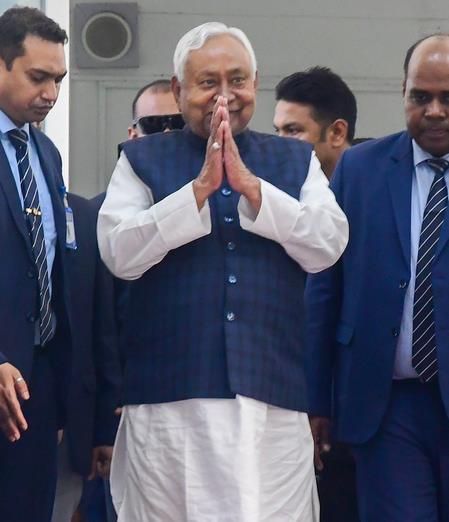
Nitish Kumar To Take Oath As CM For 10Th Time PM Modi To Attend Swearing-In Ceremony
In addition to Prime Minister Modi, the ceremony will be attended by Home Minister Amit Shah, Defence Minister Rajnath Singh, BJP National President J.P. Nadda, Uttar Pradesh Chief Minister Yogi Adityanath, and Maharashtra Chief Minister Devendra Fadnavis. Their presence underscores the political significance of Nitish Kumar's renewed mandate and the NDA's consolidated strength in Bihar.
Elaborate security arrangements have been made, given that more than three lakh people are anticipated to be present at the event. The administration has deployed additional police forces, installed surveillance cameras, and put emergency medical units on standby to ensure the smooth conduct of the ceremony.
On Wednesday, Nitish Kumar submitted his resignation as the outgoing Chief Minister to Governor Arif Mohammad Khan, paving the way for the formation of a new government. He was accompanied during the visit by Union Minister Chirag Paswan, RLM chief Upendra Kushwaha, and Uttar Pradesh Deputy Chief Minister Keshav Prasad Maurya.
Kumar was formally elected leader of the NDA legislature party during a meeting of the newly elected MLAs. Senior leader Samrat Choudhary was chosen as the BJP legislature party leader, while Vijay Kumar Sinha was selected as the deputy leader. Keshav Prasad Maurya, who was appointed the BJP's central observer for the selection of the legislature party leader in Bihar, was present during the discussions and played a key role in the proceedings.
Several JD(U) leaders are expected to be inducted into the new Cabinet. Likely candidates include Bijendra Prasad Yadav, Vijay Kumar Choudhary, Shrawan Kumar, Sunil Kumar, Lesi Singh, Sheila Mandal, Madan Sahni, Ratnesh Sada, Mohammad Zama Khan, Jayant Raj, Umesh Singh Kushwaha, and Ashok Choudhary. On the BJP side, leaders likely to continue in ministerial roles include Samrat Choudhary, Prem Kumar, Mangal Pandey, Vijay Kumar Sinha, Nitish Mishra, Renu Devi, Jibesh Kumar, Neeraj Kumar Singh, Janak Ram, Hari Sahni, Kedar Prasad Gupta, Surendra Mehta, Santosh Kumar Singh, Sunil Kumar, and Motil Lal Prasad.
Nitish Kumar's political journey spans four decades and is marked by dramatic alliances, bold decisions, and a reputation for strategic flexibility. His career began in the Janata Dal, where he won his first Assembly election in 1985. During his early years, he worked closely with Lalu Prasad Yadav and supported him when the latter became Leader of Opposition in 1989. However, the partnership gradually fractured as Nitish and several colleagues became increasingly frustrated with Lalu's centralised control over the party.
In 1994, Nitish played a crucial but understated role in one of the first major rebellions against Lalu Prasad. A group of 14 MPs, led publicly by George Fernandes but driven strategically by Nitish, broke away to form Janata Dal (George). The faction soon evolved into the Samata Party, marking Nitish Kumar's first decisive political separation from Lalu and his initial attempt to build an independent political identity.
His next major shift came in 1996, when he aligned with the BJP, beginning a long and often turbulent partnership. His performance and administrative skills earned him key ministerial roles in the Atal Bihari Vajpayee-led NDA government between 1998 and 2004, including the important portfolio of Railway Minister, where he was widely credited for introducing several reforms.
Nitish's first brief stint as Chief Minister came in 2000, with the BJP's backing. However, lacking the required numbers, his government fell within seven days. He made a strong comeback in 2005, ending Lalu Prasad Yadav's 15-year rule and launching what many analysts call Bihar's“reconstruction era”. For nearly a decade, Nitish Kumar governed without significant political challenge.
The stability ended in 2013, when Nitish severed ties with the BJP after PM Narendra Modi was declared the party's prime ministerial candidate. The decision was framed as an ideological stand but resulted in political instability and weakening of the JD(U) within the state.
In a major comeback move in 2015, Nitish reunited with Lalu Prasad Yadav to form the Mahagathbandhan, a grand alliance that defeated the BJP and returned him to power. However, the revived partnership again proved short-lived. In 2017, citing corruption allegations within the coalition, Nitish abruptly withdrew from the alliance and returned to the BJP-led NDA, earning a national reputation as a leader willing to take sudden political U-turns.
In 2022, accusing the BJP of attempting to split the JD(U), he again left the NDA and rejoined the Mahagathbandhan. But this chapter lasted only two years. With the 2024 General Elections approaching, Nitish once more returned to the NDA, a move his critics called predictable but his supporters hailed as pragmatic.
In 2025, his political calculations appear to have worked yet again. With his alliance firmly in place and electoral support renewed, Nitish Kumar is set to take oath as Chief Minister for the tenth time, cementing his status as one of India's most enduring -- and unpredictable -- political figures.

Legal Disclaimer:
MENAFN provides the
information “as is” without warranty of any kind. We do not accept
any responsibility or liability for the accuracy, content, images,
videos, licenses, completeness, legality, or reliability of the information
contained in this article. If you have any complaints or copyright
issues related to this article, kindly contact the provider above.

















Comments
No comment